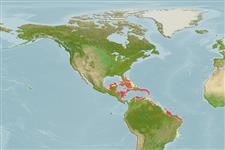Environment: milieu / climate zone / depth range / distribution range
Ecologia
marino demersale; distribuzione batimetrica 0 - 650 m (Ref. 123567). Tropical
Western Central Atlantic: off Cuba and Bahamaa and off Brazil. Probably has a wide range of distribution.
Size / Peso / Age
Maturity: Lm ? range ? - ? cm
Max length : 30.0 cm TL maschio/sesso non determinato; (Ref. 26340); common length : 20.0 cm TL maschio/sesso non determinato; (Ref. 5217)
Spine dorsali (totale): 10; Raggi dorsali molli (totale): 10; Spine anali 3; Raggi anali molli: 7. This species is distinguished from its congeners by the following set of characters: lower jaw with a row of conical teeth posterior to a canine tooth near symphysis; absence of basioccipital fossa; proximal-middle radial of first anal-fin pterygiophore with no concavity on anterior surface; pectoral-fin rays 15 (rarely 16); first gill arch with 14-16 gill rakers on lower arm; lateral-line scales 43-45; body depth 32.1-36.8% SL (Ref. 123567).
Inhabits rocky bottoms to depths less than 100 m.
Life cycle and mating behavior
Maturità | Riproduzione | Deposizione | Uova | Fecundity | Larve
Yamanoue, Y., 2016. Revision of the genus Verilus (Perciformes: Acropomatidae) with a description of a new species. J. Fish Biol., 89(5):2375-2398. (Ref. 123567)
IUCN Red List Status (Ref. 130435)
Threat to humans
Harmless
Human uses
Informazioni ulteriori
Nomi ComuniSinonimiMetabolismoPredatoriEcotossicologiaRiproduzioneMaturitàDeposizioneSpawning aggregationFecundityUovaEgg development
BibliografiaAcquacolturaProfilo di acquacolturaVarietàGeneticaElectrophoresesEreditarietàMalattieElaborazioneNutrientsMass conversion
CollaboratoriImmaginiStamps, Coins Misc.SuoniCiguateraVelocitàModalità di nuotoArea branchialeOtolithsCervelliVista
Strumenti
Special reports
Download XML
Fonti Internet
Estimates based on models
Preferred temperature (Ref.
123201): 25.3 - 28.1, mean 27 °C (based on 108 cells).
Phylogenetic diversity index (Ref.
82804): PD
50 = 0.7500 [Uniqueness, from 0.5 = low to 2.0 = high].
Bayesian length-weight: a=0.01148 (0.00468 - 0.02819), b=3.03 (2.82 - 3.24), in cm total length, based on LWR estimates for this (Sub)family-body shape (Ref.
93245).
Trophic level (Ref.
69278): 4.0 ±0.6 se; based on size and trophs of closest relatives
Fishing Vulnerability (Ref.
59153): Low vulnerability (20 of 100).
